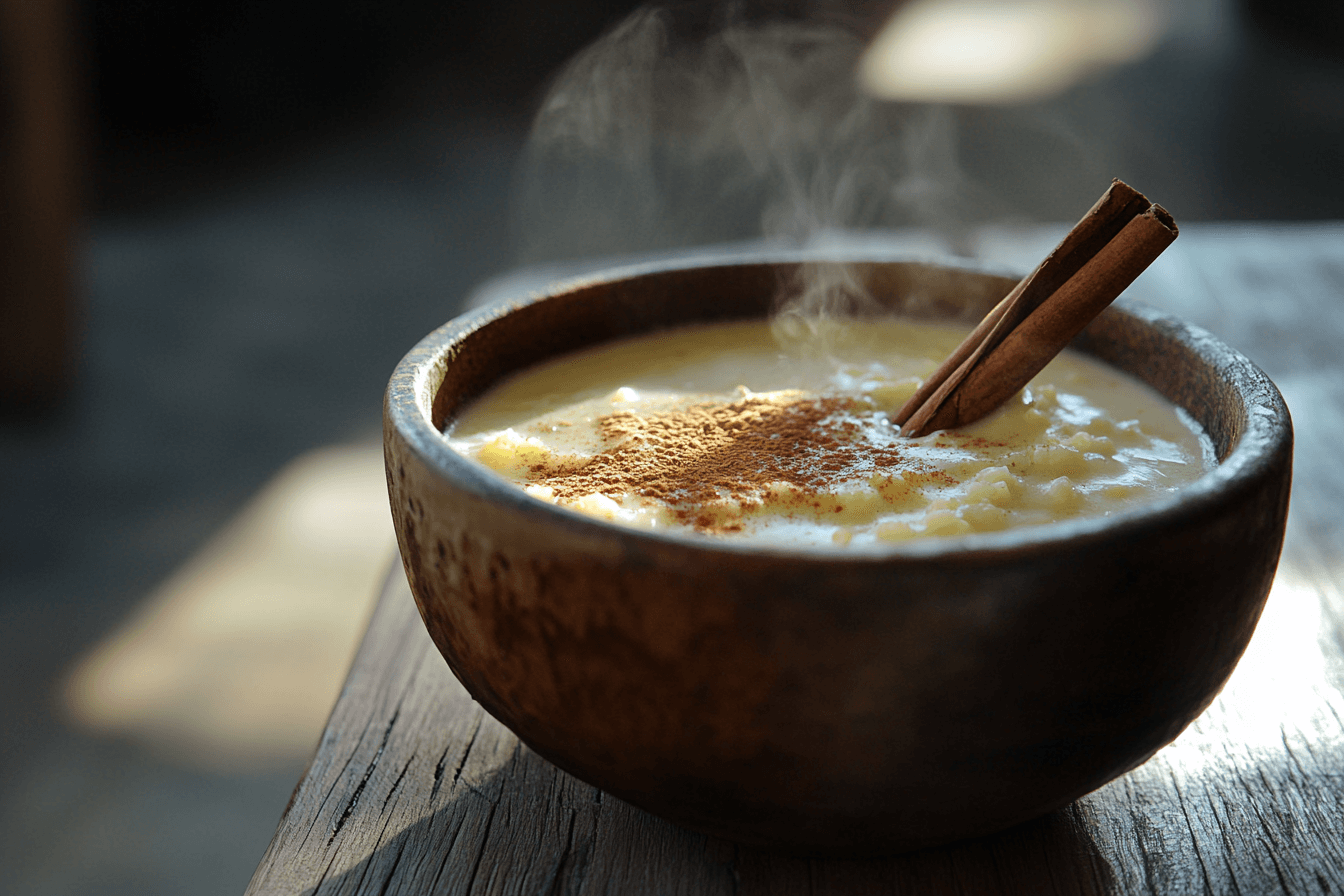Introduction
Arroz con leche is a cherished dish that merges sweet, creamy, and aromatic elements in one comforting bowl. In many Latin American countries, this dessert brings families together, creating warm memories at the dinner table. When people mention this treat, they are referring to a dish similar to rice pudding. It features soft rice simmered in milk or cream, spiced with a hint of cinnamon or vanilla, and sweetened to taste. Some cooks add a dash of citrus zest. Others throw in a handful of raisins. However, everyone agrees that arroz con leche is simple yet flavorful.
Yet, a lingering question often arises among food enthusiasts: Is arroz con leche supposed to be cold or hot? Opinions are strong. Preferences differ. Furthermore, curiosity grows when people realize how versatile this dessert can be. In fact, arroz con leche adapts so well that it can shine whether it is served warm or chilled. Both options appeal to distinct tastes, and each version carries its own charm.
This article explores the best ways to serve arroz con leche and examines its many variations. You will learn about the cultural significance behind serving it warm. You will also discover why some individuals prefer it cooled. Additionally, you will find tips for cooking and storing arroz con leche in the easiest way possible. Moreover, you will see how to enhance its flavors and adapt the recipe to suit everyone’s taste buds. Let’s begin by answering the key question about whether arroz con leche should be served cold or hot.
Is Arroz Con Leche Supposed to Be Cold or Hot?
This question sparks passionate debates among fans of this creamy rice dessert. Traditionally, many households serve arroz con leche fresh off the stove. They delight in the inviting steam and the aroma of cinnamon swirling in the air. On the other hand, numerous cooks chill this treat in the fridge, especially when preparing it in advance. Some folks argue that it tastes best once it sets and achieves a custard-like texture. Others believe nothing beats the comforting feel of warm rice pudding on a chilly evening.
So, which is correct? The truth is that there is no single “right” answer. Ultimately, you get to decide if arroz con leche is supposed to be cold or hot based on taste, tradition, and personal preference. Below, we will explore the reasons behind each style. We will also provide simple ways to adapt your recipe, so you can relish both approaches.
The Tradition of Hot Arroz Con Leche
Warm arroz con leche is deeply woven into many family gatherings. It is often a staple during breakfast time or late-night snacks. Because the dish exudes a cozy vibe, serving it hot can create a sense of togetherness. In many Latin American cultures, there is something reassuring about passing around a pot of steamy arroz con leche, then sprinkling a little cinnamon on top.

Why People Love It Warm
- Comfort Factor
A hot bowl of arroz con leche feels nurturing. Many people cherish memories of their parents or grandparents cooking it on cold mornings. Moreover, the warmth amplifies the sweetness, allowing the flavors to bloom. - Quick Gratification
When arroz con leche is done cooking, you can serve it right away. It does not require additional waiting or chilling. Therefore, it is a convenient choice if you crave a sweet treat immediately. - Enhanced Aromas
Heating milk, rice, and cinnamon together releases powerful scents. In fact, the aromatic steam can transform your kitchen. Because smell is tied to taste, the overall enjoyment intensifies. - Creamy Texture
Hot arroz con leche maintains a soft, creamy consistency. The rice stays tender, and the liquid retains a velvety thickness. In addition, the warm milk mixture clings to each grain, making every bite rich.
Serving Warm Arroz Con Leche
When serving it hot, many cooks like to top arroz con leche with extra cinnamon or ground nutmeg. You can also add a pat of butter to lend a silky finish. Some prefer to garnish it with fresh fruit slices, such as bananas or strawberries. Others enjoy it plain with a light dusting of cocoa powder. Because the dessert is already sweet, keep toppings modest to avoid overwhelming the flavor.
The Pleasure of Chilled Arroz Con Leche
On the flip side, chilled arroz con leche offers a refreshing twist on the classic dessert. Many people around the world love cold rice pudding for its dense, pudding-like texture. It sets more firmly, which can make each spoonful feel delightfully thick.

Why Chilled Arroz Con Leche Shines
- Refreshing Treat
When the weather is hot, a cooled serving of arroz con leche can be exactly what you need. It soothes the palate. It also provides a subtle sweetness without feeling too heavy. - Portable Dessert
You can prepare cold arroz con leche in advance. Then, you can store it in individual cups or bowls. Consequently, it becomes easy to pack for work, school, or picnics. - Perfect for Layering
Chilled arroz con leche is firm enough to layer with other ingredients. You could add fresh berries, fruit compote, or whipped cream. By contrast, hot arroz con leche can sometimes make such additions tricky. - Longer Shelf Life
Storing arroz con leche in the refrigerator helps extend its freshness. You can keep it for a few days, making it a handy dessert for surprise guests or quick snacks.
Serving Suggestions for Chilled Arroz con Leche
When you serve it cold, consider adding bright flavors that contrast the creaminess. Raspberries, mango slices, or a drizzle of chocolate sauce can provide a sweet contrast. Additionally, toasted coconut flakes or chopped nuts can introduce a lovely crunch. Another fun idea is to serve cold arroz con leche in small mason jars for an appealing, grab-and-go dessert.
Comparing Textures and Flavors
Different serving temperatures lead to distinct textures and flavor experiences. Therefore, whether arroz con leche is supposed to be cold or hot often depends on how you want to experience it.
- Temperature Impact
Heat tends to accentuate spices like cinnamon. It also makes the dessert feel lighter. Conversely, chilling the dish intensifies the custard-like consistency, making the flavor slightly more subdued but still sweet. - Mouthfeel
Warm arroz con leche can feel silky and soothing. Meanwhile, cold arroz con leche has a denser bite. If you enjoy a more luscious dessert, chilling might be your choice. However, if you like a creamier spoonful, warm is better. - Practical Factors
Serving size matters too. If you are hosting a large group, cold portions can be prepped ahead of time and kept in the fridge. But if you have a cozy gathering at home, hot arroz con leche may set the right mood.
Tips for Preparing Arroz Con Leche
Regardless of the final temperature, the steps for making arroz con leche remain fairly consistent. Here are some tips to simplify the process:
- Choose the Right Rice
Short-grain rice works best because it becomes soft and starchy. Yet, if you only have long-grain rice, you can still make a tasty dish. Cook it a bit longer to achieve the desired tenderness. - Simmer Gently
Arroz con leche cooks slowly. First, bring water or milk to a light boil. Then, add the rice and reduce the heat. Let it simmer until the grains turn tender. Stir often. This prevents the mixture from sticking to the bottom of the pot. - Use Quality Dairy
Whole milk or a mix of milk and cream yields a rich result. Some people even add condensed milk for extra sweetness. If you prefer a lighter version, low-fat milk or plant-based milk alternatives can also work. - Flavor Enhancers
Classic arroz con leche calls for cinnamon sticks. You can also stir in a bit of vanilla extract or lemon zest. As the dish cooks, these flavor boosters infuse the mixture, resulting in a fragrance that wafts through your kitchen. - Sweeten Gradually
Always add sugar or condensed milk in small amounts. Taste as you go. That way, you can adjust the level of sweetness. Remember, it is easier to add more sugar than to remove it. - Consider Texture
For a thicker dessert, let the mixture cook until it reaches your preferred consistency. Or, if you like it looser, add more milk near the end of cooking. Once finished, you can add in extras like raisins, shredded coconut, or dried fruit.
Serving Suggestions
Arroz con leche offers countless ways to please your palate. Thus, deciding if it should be cold or hot might also depend on your menu and the event. Below are some creative serving ideas:

- Family Breakfast
Dish up warm arroz con leche with a dusting of cinnamon and a cup of coffee or hot chocolate. It makes a comforting start to the day. Kids often adore it because it feels like a sweet treat in the morning. - Dessert Buffet
For social gatherings, prepare cold arroz con leche in small ramekins. Then, decorate each portion with fruit or whipped cream. Place them on a tray. Guests can admire the neat presentation and enjoy a cool sweet bite. - Garnishes
Sprinkling some grated chocolate, caramel drizzle, or chopped nuts on top can uplift the dessert’s look and taste. A cinnamon stick garnish also conveys a homemade charm. - Pairing
If you serve arroz con leche after a spicy meal, consider the chilled version. The coolness helps balance strong flavors. Conversely, if your meal was light, a warm bowl feels indulgent and satisfying.
Variations and Regional Influences
Arroz con leche has many forms across the globe. In Spain, a version called “arroz con leche Asturiano” usually includes lemon peel and is often served chilled. Meanwhile, in Mexico, warm arroz con leche is common at breakfast or as a comforting snack at night. In the Caribbean, some cooks add coconut milk. In Peru, raisins and sweetened condensed milk are popular additions.
These regional preferences shape how people choose to eat arroz con leche. In some cases, it is always served hot. In other regions, it is almost always cold. However, modern kitchens are flexible. Many families switch between both styles based on the season. For example, they might serve hot arroz con leche in winter and chilled arroz con leche in summer.
Storing and Reheating
It is possible to store arroz con leche, whether hot or cold, for several days. Remember these guidelines to keep your dessert fresh:
- Refrigeration
Place leftovers in an airtight container. Store in the fridge for up to four days. Cold arroz con leche maintains its consistency well. Over time, it might thicken, so add a splash of milk to loosen if needed. - Freezing
Although not as common, you can freeze arroz con leche. The texture may change slightly, but the taste usually remains good. Thaw it in the refrigerator and warm it gently in a saucepan if you prefer a hot serving. - Reheating
If you have chilled arroz con leche and want it hot, you can transfer it to a pot and warm it over low heat. Stir in extra milk if it has thickened too much. Make sure to heat it evenly, and watch for sticking on the pot’s bottom. - Serving Again
After reheating, taste and adjust sweetness or spice. The flavors may evolve over time, so a pinch of cinnamon or sugar can refresh the dish.
Frequently Asked Questions
How do you reheat arroz con leche?
Place chilled arroz con leche in a saucepan. Add a small amount of milk to restore a creamy texture. Heat it over low heat. Stir occasionally. Once it reaches the desired warmth, turn off the heat. Then serve with a sprinkle of cinnamon on top.
How do you eat arroz con leche?
You can enjoy arroz con leche straight from the pot while it’s warm. Or you can let it cool in the fridge and eat it chilled. Both ways taste great. Some prefer it as a light breakfast, while others enjoy it as an after-dinner dessert.
Are you supposed to eat rice pudding hot or cold?
Rice pudding is versatile. Many people serve it hot right after cooking. Others chill it to make a thicker treat. There is no wrong method. You can pick based on your mood or the occasion.
Is arroz con leche better cold or hot?
This depends entirely on personal preference. Warm arroz con leche feels soothing and aromatic. Chilled arroz con leche is refreshing and dense. Try both styles to see which one you enjoy more.
Conclusion
Is arroz con leche supposed to be cold or hot? The short answer is that it is completely up to you. Each temperature style reveals unique aspects of this sweet, creamy dessert. Serving it warm showcases comforting aromas and immediate satisfaction. Offering it chilled highlights a dense consistency and easy advance preparation. In the end, arroz con leche remains a timeless dish that brings people together. Whether you savor it as a steaming bowl on a winter morning or as a cool dessert on a summer day, its sweetness and familiar taste will always lift your spirits. So, enjoy it according to your preference, and do not be afraid to experiment with new flavors, toppings, and serving styles. After all, arroz con leche is meant to be a joyful indulgence.

